Saltwater fishing rigs are essential for targeting various marine species. They combine hooks‚ lines‚ and sinkers to optimize catches. Popular rigs include Pennel and Carolina setups‚ ensuring effective fishing experiences.
1.1 What Are Saltwater Fishing Rigs?
Saltwater fishing rigs are specialized setups designed to target marine species. They consist of hooks‚ lines‚ sinkers‚ and swivels‚ tailored for specific fishing conditions and species. These rigs enhance the effectiveness of bait or lures‚ improving catch rates. Popular rigs include the Pennel Rig for large baits and the Carolina Rig for bottom fishing. They are adaptable to various environments‚ from shallow waters to deep seas‚ making them indispensable for anglers. Whether fishing from a boat or shore‚ the right rig ensures better presentation and control‚ increasing the chances of landing fish. Understanding and mastering these setups is crucial for successful saltwater angling.
1.2 Importance of Using the Right Rig
Using the right saltwater fishing rig is crucial for a successful angling experience. The correct setup enhances the effectiveness of bait or lures‚ increasing the likelihood of attracting and landing fish. A well-chosen rig adapts to specific fishing conditions‚ such as water depth and target species‚ ensuring optimal performance. It also improves bait presentation‚ making it more appealing to marine life. Additionally‚ the right rig minimizes gear loss and reduces the risk of tangles‚ saving time and effort. Properly rigged tackle ensures safety‚ especially in deep-sea or rough conditions. By selecting the appropriate rig‚ anglers can maximize their chances of a productive and enjoyable fishing trip. This fundamental aspect of saltwater fishing underscores the importance of understanding and utilizing the correct configurations for varying scenarios.
1.3 Brief History of Saltwater Fishing Rigs
The history of saltwater fishing rigs dates back to ancient times‚ with early anglers using primitive materials like bone‚ stone‚ and plant fibers. These early rigs were simple‚ consisting of hooks made from sharpened bones and lines crafted from vines or animal sinew. As civilizations evolved‚ so did fishing techniques‚ with the development of metal hooks and more durable lines. The Middle Ages saw the introduction of more sophisticated rigs‚ while the Industrial Revolution brought mass-produced tackle‚ making fishing more accessible. Modern saltwater fishing rigs have evolved further‚ incorporating synthetic materials and innovative designs like the Pennel and Carolina rigs. These advancements have significantly improved fishing efficiency and adaptability to various marine environments. Understanding this history provides insight into how rigs have been refined to meet the challenges of saltwater angling.
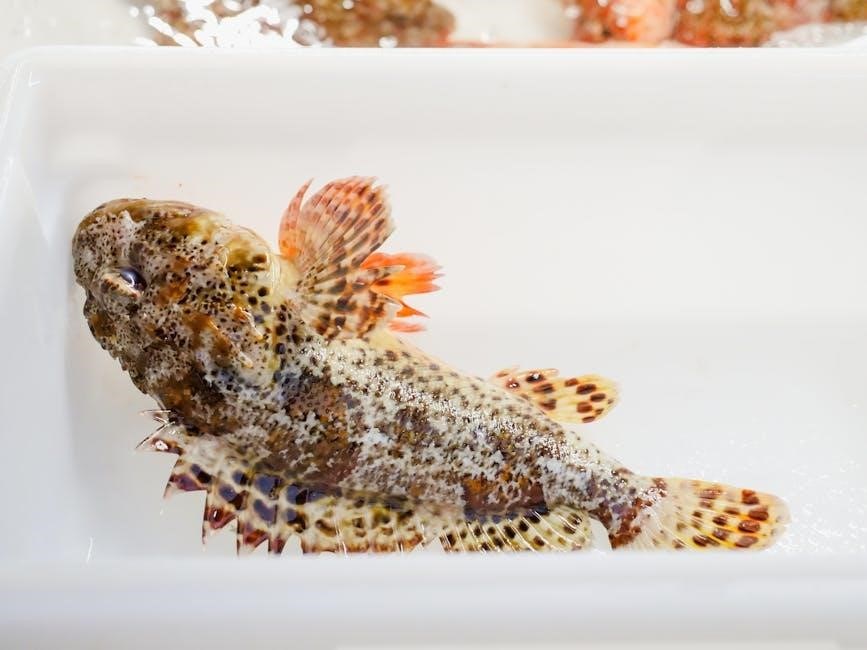
Essential Components of Saltwater Fishing Rigs
Saltwater fishing rigs consist of hooks‚ lines‚ swivels‚ and sinkers. These components work together to present bait effectively and handle the demands of marine fishing conditions and species.
2.1 Hooks: Types and Sizes
Hooks are a critical component of saltwater fishing rigs‚ available in various types and sizes to suit different fishing techniques and species. Common types include bait holder hooks‚ egg hooks‚ and octopus hooks‚ each designed for specific baits or lures. Hook sizes range from small‚ fine-wire models for delicate fish like trout to large‚ sturdy hooks for tackling species like tuna or snapper. The choice of hook size and type depends on the target species‚ bait used‚ and fishing conditions. For example‚ larger hooks are ideal for big baits‚ while smaller hooks are better for smaller prey. Using the right hook ensures effective hooksets and minimizes the risk of losing fish. Proper hook selection is essential for a successful saltwater fishing experience.
2.2 Fishing Lines: Monofilament‚ Braid‚ and Fluorocarbon
Fishing lines are a vital part of saltwater fishing rigs‚ with three main types: monofilament‚ braid‚ and fluorocarbon; Monofilament is durable‚ easy to handle‚ and offers good knot strength‚ making it a popular choice for beginners. Braid‚ known for its exceptional strength and sensitivity‚ is ideal for deep-sea fishing and tackling large species. Fluorocarbon‚ nearly invisible underwater‚ is favored for its fast sink rate and abrasion resistance‚ making it perfect for clear waters and bottom fishing. Each type has unique advantages‚ and the choice depends on fishing conditions‚ target species‚ and personal preference. Selecting the right line ensures better performance and increases the chances of a successful catch in saltwater environments.
2.3 Swivels: Purpose and Selection
Swivels are crucial components in saltwater fishing rigs‚ serving to prevent line twisting and tangles. They are especially useful when using live bait or lures that spin‚ ensuring smooth line movement. When selecting a swivel‚ consider the material—stainless steel or brass are durable options for saltwater. Size should match the fishing line’s strength to handle the target species. A high-quality swivel minimizes the risk of line failure during fights with large fish. Properly attaching a swivel ensures optimal performance and reduces the chances of losing gear. Swivels are indispensable in both bottom fishing and trolling setups‚ providing reliability in challenging marine conditions. Choosing the right swivel enhances the overall efficiency of the rig and contributes to a successful fishing experience.
2.4 Sinkers: Types and Uses
Sinkers are essential components in saltwater fishing rigs‚ designed to sink bait or lures to desired depths. Common types include egg sinkers‚ pyramid sinkers‚ and bank sinkers. Egg sinkers are versatile and suitable for bottom fishing‚ while pyramid sinkers are ideal for surf fishing due to their ability to hold in sandy or muddy bottoms. Bank sinkers are large and used for deep-sea fishing. Sinkers are typically made of lead or steel‚ with sizes varying based on water conditions and target species. They prevent bait from floating and ensure it reaches the intended depth. Properly selecting and attaching a sinker enhances the effectiveness of the rig‚ allowing anglers to present bait naturally to marine life. Sinkers are crucial for maximizing catch rates in various saltwater environments‚ from shallow coastal areas to deep offshore waters.
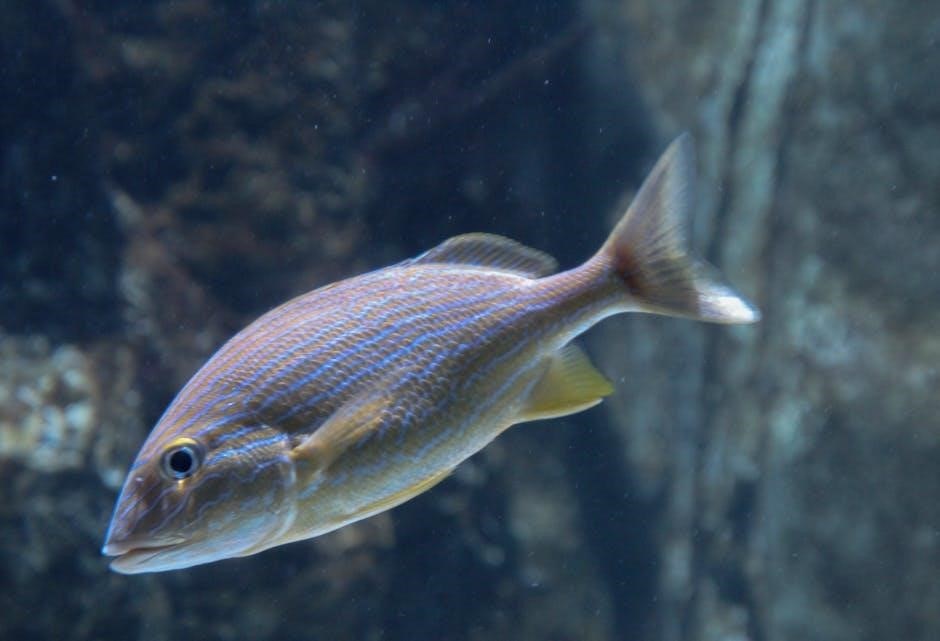
Popular Saltwater Fishing Rigs
Popular saltwater fishing rigs include the Pennel Rig‚ Carolina Rig‚ Texas Rig‚ Float Rig‚ and Bottom Rig. These setups are tailored for specific fishing conditions and target species‚ enhancing the chances of a successful catch.
3.1 Pennel Rig: Setup and Usage
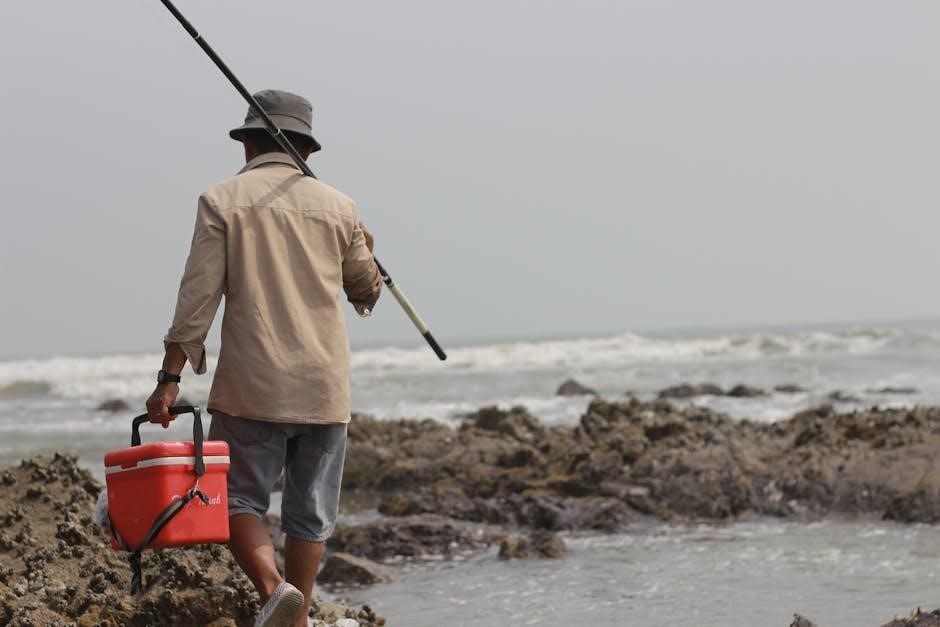
The Pennel Rig is a popular saltwater fishing setup‚ ideal for using large bait. It consists of two hooks attached to a single line‚ with a swivel to prevent line twist. To set it up‚ thread the line through the swivel‚ then attach the hooks at intervals. This rig is effective for bottom fishing and targeting species like cod or snapper. When using live or cut bait‚ the Pennel Rig allows natural movement‚ attracting larger predators. It’s commonly used in inshore and offshore waters‚ offering versatility and strength for heavy-duty fishing. The rig’s design minimizes tangles and ensures both hooks can work independently‚ making it a reliable choice for anglers seeking substantial catches in various saltwater environments.
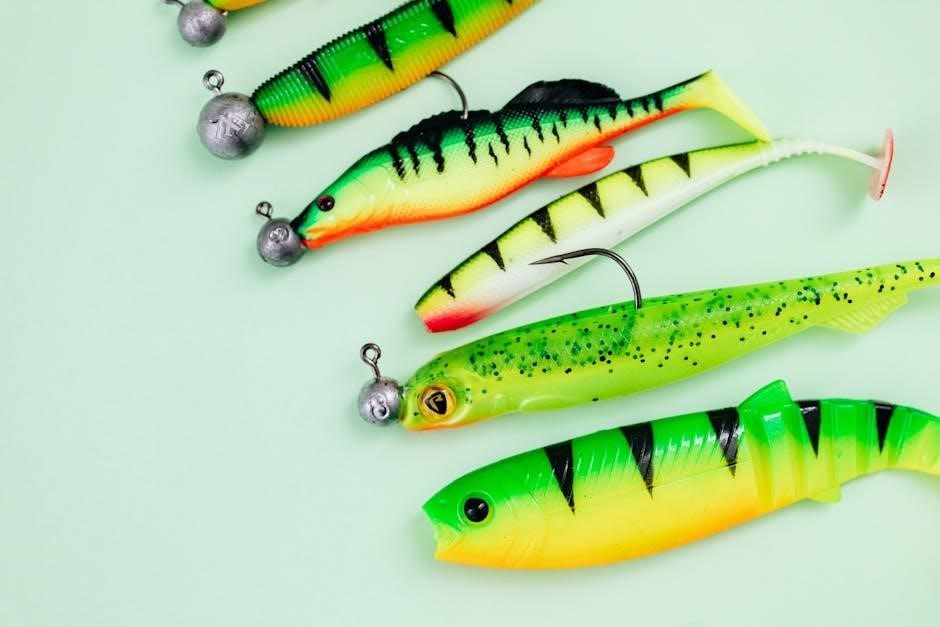
3.2 Carolina Rig: Setup and Usage
The Carolina Rig is a versatile saltwater fishing setup‚ ideal for targeting species like trout‚ redfish‚ and flounder. It consists of a swivel‚ beads‚ and a weighted sinker‚ allowing the bait to move naturally. To set it up‚ attach the swivel to the main line‚ then thread on the beads and sinker. Tie a hook to the end‚ typically using a uni knot. This rig excels in shallow waters and soft bottoms‚ as the weight holds the bait near the seafloor. It’s effective with live or artificial lures‚ making it a favorite for both beginners and experienced anglers. The Carolina Rig’s simplicity and adaptability make it a go-to choice for various saltwater fishing scenarios‚ ensuring consistent results in diverse marine environments.
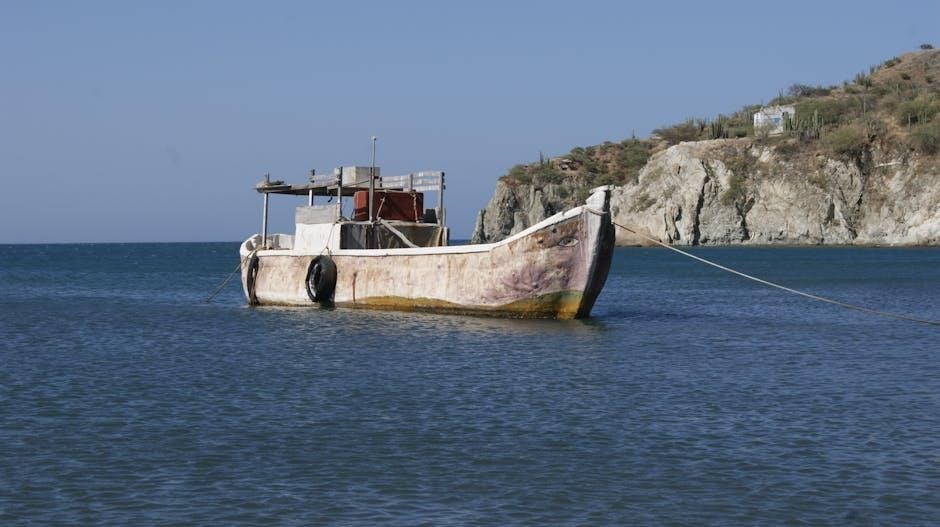
3.3 Texas Rig: Setup and Usage
The Texas Rig is a popular saltwater fishing setup known for its versatility and effectiveness in various environments. It typically consists of a swivel‚ a weighted sinker‚ and a hook‚ allowing for precise presentation of bait or lures. To set it up‚ attach the swivel to the main line‚ then thread the sinker and tie the hook using a reliable knot like the uni knot. This rig is ideal for bottom fishing and structure fishing‚ targeting species such as snapper‚ grouper‚ and redfish. Its weighted design ensures the bait stays near the seafloor‚ while the swivel prevents line twisting. The Texas Rig is also weedless‚ making it perfect for fishing in areas with heavy vegetation or debris. Its simplicity and adaptability make it a favorite among anglers‚ providing consistent results in diverse saltwater conditions.
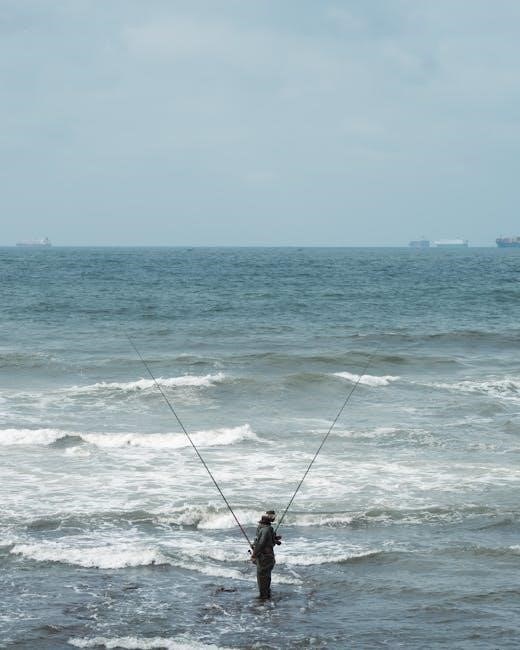
3.4 Float Rig: Setup and Usage
The Float Rig is a versatile saltwater fishing setup designed to suspend bait or lures at a specific depth. It consists of a float‚ a weighted line‚ and a hook‚ often combined with a swivel to prevent line twisting. To set it up‚ attach the float above the hook using a stop knot‚ ensuring the bait remains suspended. This rig is ideal for targeting species like trout‚ snapper‚ and mackerel in shallow waters or near structures. The float allows for natural bait movement‚ attracting fish effectively. It’s also useful for surf fishing‚ as it keeps the bait off the bottom‚ reducing snagging. The Float Rig is easy to assemble and adaptable to various fishing conditions‚ making it a popular choice for both beginners and experienced anglers seeking to maximize their catch in saltwater environments.
3.5 Bottom Rig: Setup and Usage
The Bottom Rig is a saltwater fishing setup designed to fish near or on the ocean floor. It typically consists of a weighted line‚ a swivel‚ and a hook‚ often with a float to suspend bait above the bottom. To set it up‚ attach the sinker directly to the line or via a swivel to prevent twisting. Bait such as squid‚ shrimp‚ or lures is then hooked‚ and the rig is cast or dropped from a boat. The Bottom Rig is effective for species like snapper‚ grouper‚ and halibut. It’s ideal for deep waters and structured areas‚ allowing the bait to attract bottom-dwelling fish. This rig is simple to assemble and highly adaptable‚ making it a favorite for anglers targeting specific species in various saltwater conditions.
Knots for Saltwater Fishing Rigs
Essential knots like the Uni Knot and Grinner Knot are crucial for saltwater fishing rigs. These reliable knots securely connect hooks and swivels‚ ensuring durability in deep-sea conditions.
4.1 Uni Knot: Step-by-Step Guide
The Uni Knot is a versatile and reliable knot for saltwater fishing rigs. To tie it‚ thread the fishing line through the hook or swivel eye. Hold the line between your thumb and index finger‚ forming a loop. Wrap the line around itself 5-6 times‚ then pass the end through the loop. Moisten the knot with saliva or water and pull both ends to tighten it. This knot is excellent for connecting hooks‚ swivels‚ and lures‚ ensuring a secure connection even in deep-sea conditions. Its simplicity and strength make it a favorite among anglers for saltwater fishing rigs.
4.2 Grinner Knot: Step-by-Step Guide
The Grinner Knot is a dependable choice for saltwater fishing rigs‚ offering a secure connection between the line and hook or swivel. To tie it‚ thread the line through the eye of the hook or swivel. Hold the line in one hand and create a loop with the tag end. Wrap the tag end around the standing line 5-6 times‚ then pass it through the loop. Moisten the knot with water or saliva to reduce friction. Pull the tag end gently to tighten the knot‚ ensuring it sits snugly against the eye. This knot is highly reliable for deep-sea fishing and withstands the stress of heavy catches. Its simplicity and strength make it a favorite among saltwater anglers for securing their rigs effectively.
Species-Specific Saltwater Fishing Rigs
Species-specific rigs are tailored to target fish like trout‚ snapper‚ and tuna. Each setup is designed to match the feeding habits and size of the target species‚ ensuring effective results.
5.1 Trout Fishing Rigs
Trout fishing rigs are designed to effectively target trout in saltwater environments. A basic setup includes a swivel to prevent line twisting and a hook size 2 to 6‚ depending on the trout size. Using live or artificial baits like lures or spoons can enhance attraction. For bottom fishing‚ a float rig with a rubber band and hook is effective‚ allowing the bait to suspend at desired depths. When using larger baits‚ a Pennel Rig is recommended‚ replacing the single hook for better bait presentation. Ensuring the rig is balanced and matches the bait size is crucial for successful trout fishing; This setup is ideal for both beginners and experienced anglers targeting trout in coastal areas.
5.2 Snapper Fishing Rigs
Snapper fishing rigs are tailored to target these strong-fighting species in saltwater environments. A popular choice is the Pennel Rig‚ which uses two hooks to secure large baits like squid or fish fillets. This rig is ideal for bottom fishing‚ where snappers often reside. Another effective setup is the Carolina Rig‚ featuring an egg sinker and swivel‚ allowing the bait to move naturally. Hooks should be sturdy‚ typically size 2 to 5/0‚ depending on the snapper size. Using live or cut baits is recommended‚ as snappers are attracted to strong scents. The rig should be balanced to ensure the bait presents enticingly on the seafloor. Properly setting the rig is crucial for hooking and landing these powerful fish‚ making snapper fishing rigs a must-have for saltwater anglers targeting this species.
5.3 Tuna Fishing Rigs
Tuna fishing rigs are designed to handle the strength and speed of these powerful fish. A common setup is the double hook rig‚ which allows anglers to present live bait or lures effectively. Heavy-duty lines and swivels are essential to prevent line twist and wear. For trolling‚ a spoon rig or plastic lure rig is often used‚ attracting tuna with vibrant colors and movement. When using bait‚ a sturdy single hook or treble hook is recommended to secure larger baits like mackerel or squid. The rig should be balanced to ensure the bait or lure moves naturally‚ enticing tuna to strike. Proper setup and presentation are critical for success‚ as tuna are highly active and require precise techniques to hook and land effectively.
Tackle and Gear Selection for Saltwater Fishing
Choosing the right tackle and gear is crucial for saltwater fishing. Medium to heavy action rods and reels with strong drag systems are ideal. Swivels and hooks are essential components‚ ensuring durability and reliability. Proper line selection‚ including monofilament or braid‚ enhances performance. Always use high-quality gear to withstand the demands of saltwater environments and larger fish species.
6.1 Rods: Choosing the Right Rod for Saltwater Fishing
Selecting the right rod for saltwater fishing is critical for success. Saltwater rods are typically medium to heavy action‚ designed to handle larger species and harsh marine conditions. Graphite or fiberglass rods are popular choices‚ offering durability and sensitivity. Rod length usually ranges from 7 to 12 feet‚ depending on the fishing technique. For surfcasting‚ longer rods (10-12 feet) are ideal‚ while shorter rods (7-9 feet) are better for boat fishing. The action of the rod should match the type of fishing‚ with fast action rods suited for trolling and medium action rods preferred for bottom fishing. Ensuring the rod is compatible with the reel and line strength is essential for optimal performance. Proper rod selection enhances casting accuracy and fighting power‚ making it a vital component of any saltwater fishing setup.
6.2 Reels: Choosing the Right Reel for Saltwater Fishing
Selecting the right reel for saltwater fishing is crucial for a successful angling experience. Saltwater reels are designed to withstand harsh marine conditions and handle larger‚ stronger species. Baitcasting‚ spinning‚ and trolling reels are popular choices‚ each suited for specific fishing techniques. Spinning reels are ideal for surfcasting and light tackle‚ while baitcasting reels offer precision and control for heavier applications. Trolling reels are built for deep-sea fishing‚ with high line capacity and robust drag systems. When choosing a reel‚ consider factors like corrosion resistance‚ gear ratio‚ and drag strength. Stainless steel or aluminum frames are durable options. Ensure the reel is paired with a compatible rod and line to maximize performance. Regular maintenance is essential to prevent corrosion and extend the reel’s lifespan. The right reel can make a significant difference in landing trophy fish and enjoying a seamless fishing experience.
6.3 Lines: Choosing the Right Line for Saltwater Fishing
Choosing the right fishing line is vital for saltwater fishing success. Three main types are monofilament‚ braid‚ and fluorocarbon. Monofilament is durable‚ easy to knot‚ and suitable for beginners. Braid offers exceptional strength‚ sensitivity‚ and minimal stretch‚ making it ideal for heavy-duty applications. Fluorocarbon is nearly invisible underwater‚ reducing fish spooking‚ and is often used as a leader. Line strength (lb test) should match the target species and fishing conditions. For shallow waters and smaller species‚ lighter lines suffice‚ while deep-sea fishing requires heavier lines. Consider water clarity‚ as fluorocarbon blends well in clear waters. Proper line selection ensures better casting performance‚ knot reliability‚ and increased chances of landing fish. Always pair the line with compatible rods and reels for optimal results. Regularly inspect lines for wear and replace them to avoid breakage during critical moments. The right line enhances both casting accuracy and fishing efficiency.
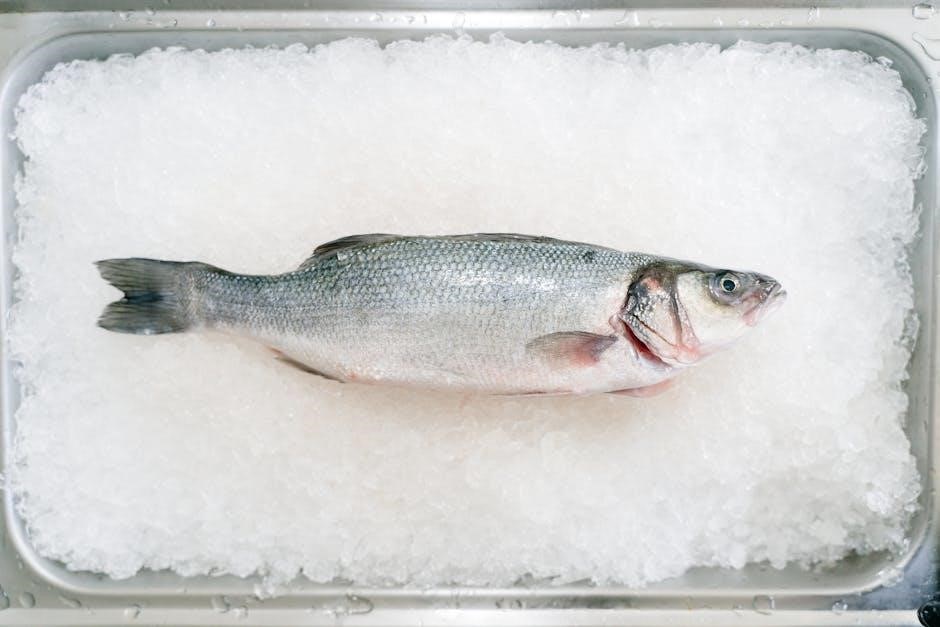
Safety and Legal Considerations
Always wear a life jacket and ensure your fishing rig is secure. Check local regulations for permits and species restrictions. Adhere to catch limits and size requirements.
7.1 Safety Gear for Saltwater Fishing
Safety is paramount in saltwater fishing. Essential gear includes a life jacket or PFD‚ which is mandatory when fishing from a boat. Always secure your fishing rig to your rod to prevent loss or accidents. A first aid kit is crucial for treating minor injuries. Sunscreen‚ polarized sunglasses‚ and a hat protect against harsh marine conditions. A whistle or other signaling device can alert others in emergencies. Proper footwear with traction is vital for slippery boat decks. Staying hydrated and bringing extra clothing are also recommended. Familiarize yourself with weather forecasts to avoid dangerous conditions. Ensure all gear is in good condition to prevent failures. Safety gear not only protects you but also enhances your overall fishing experience. Always prioritize preparedness to enjoy a safe and successful trip.
7.2 Legal Requirements for Saltwater Fishing
Understanding and adhering to legal requirements is crucial for saltwater fishing. A valid fishing license is typically mandatory‚ with specific permits for certain species. Catch limits‚ size restrictions‚ and gear regulations must be followed to ensure sustainability. Seasonal closures and protected marine areas are enforced to conserve fish populations. Familiarize yourself with local‚ state‚ or federal regulations‚ as they vary by region. Ignoring these rules can result in fines or penalties. Always check for updates before your trip‚ as laws are subject to change. Compliance not only avoids legal issues but also supports the preservation of marine ecosystems for future anglers. Respect the environment and wildlife by following all guidelines carefully. Legal awareness is an essential part of responsible and ethical saltwater fishing practices.
Resources and Further Reading

Explore detailed diagrams and tutorials for setting up saltwater fishing rigs. Guides cover various setups‚ including Pennel and Carolina rigs‚ to enhance your fishing skills and success.
8.1 Diagrams and Illustrations of Saltwater Fishing Rigs
Diagrams and illustrations are crucial for understanding saltwater fishing rig setups. They provide visual guides for assembling rigs like the Pennel and Carolina setups. Detailed illustrations show how to attach hooks‚ swivels‚ and sinkers correctly. These visuals are especially helpful for beginners‚ offering step-by-step instructions. Many diagrams focus on specific fishing techniques‚ such as surfcasting or bottom fishing. They often include labels for components like floats‚ rubber bands‚ and hooks‚ ensuring clarity. Illustrations also cover tackle and equipment‚ such as rod and reel configurations. By studying these diagrams‚ anglers can master various rig configurations‚ improving their chances of success. Whether for inshore or offshore fishing‚ diagrams are indispensable tools for anglers of all skill levels.
8.2 Tutorials and Guides for Setting Up Saltwater Fishing Rigs

Tutorials and guides are invaluable for mastering saltwater fishing rig setups. Step-by-step instructions help anglers assemble rigs like the Pennel and Carolina setups. These guides often include detailed knot-tying tutorials‚ such as the uni knot and grinner knot‚ essential for securing hooks and swivels. Video and written tutorials provide hands-on learning‚ making complex rigs accessible to beginners; Many guides focus on specific fishing techniques‚ such as surfcasting or bottom fishing‚ offering tailored advice. Practice is emphasized to ensure rigs are properly tested before use. Whether targeting trout‚ snapper‚ or tuna‚ these guides equip anglers with the skills to optimize their gear and increase fishing success. They are a must-have resource for both novice and experienced anglers.
